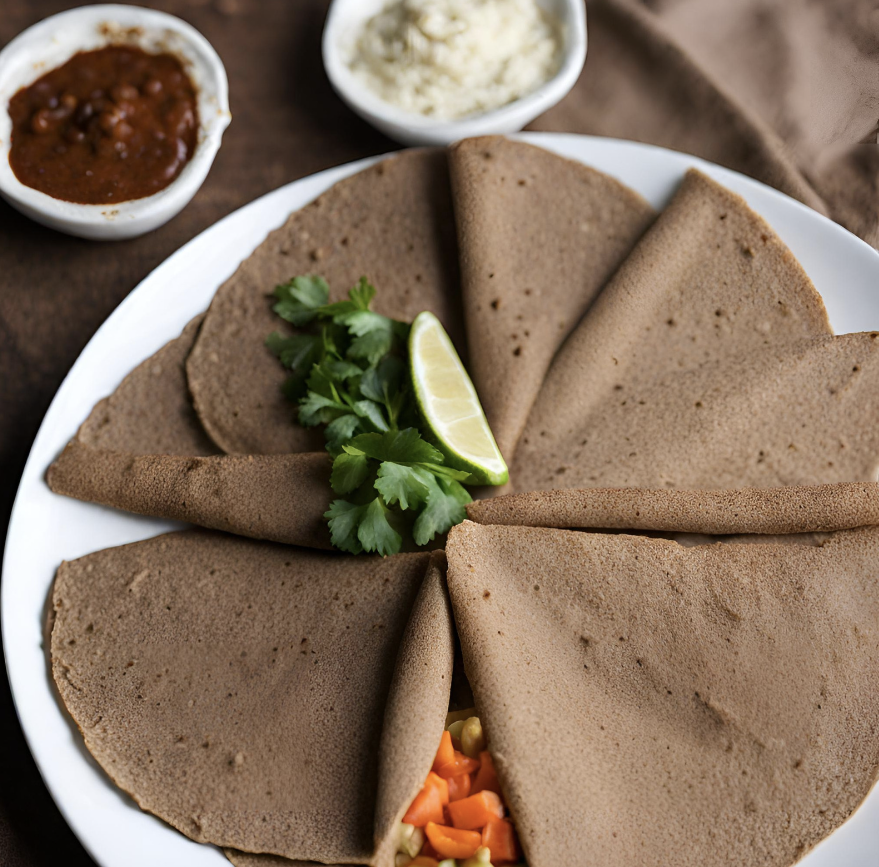Nutrition
Is Injera Healthy to Eat?
The classic Ethiopian flatbread known as injera has gained appeal in countries other than Ethiopia, where it was historically produced. Not without a valid reason! Injera is not only a versatile and delicious staple in Ethiopian cuisine, but it also has a variety of health benefits that make it a standout choice for anyone who are concerned about their health.
What is Injera Made Of?
Injera is formed with fermented teff flour, which is gluten-free and high in iron, calcium, and fiber. Teff has been cultivated in Ethiopia for thousands of years and is a staple crop. The fermentation process imparts injera’s distinctive sour flavor and spongy texture. Teff flour is mixed with water and fermented for a few days to make injera. The batter is then placed onto a hot griddle and baked until the top is covered with little holes, resulting in a one-of-a-kind and delectable flatbread.

Nutritional Benefits of Injera
Injera, which is high in nutrients, is not only delicious but also has several health benefits. Injera’s major ingredient, teff, is high in iron, calcium, and fiber. Iron is required for the synthesis of red blood cells and aids in the prevention of anemia. Calcium is essential for strong bones and teeth, while fiber helps digestion and a healthy digestive system. Injera also includes vital amino acids, making it an excellent protein source for vegetarians and vegans.
Injera and a Balanced Diet
Incorporating injera into your diet might assist you in maintaining a balanced and healthy diet. It is low in calories and fat, making it an ideal choice for people who want to lose weight. Injera’s rich fiber content keeps you satiated for longer, reducing the temptation to overeat. Injera’s low glycemic index also helps maintain blood sugar levels, making it a good choice for diabetics.
How Injera Supports Gut Health
The fermentation technique used to make injera boosts its probiotic content, which promotes gut health and aids digestion. Probiotics are helpful microorganisms that aid in the maintenance of a healthy gut flora. They promote immune system health, increase nutrient absorption, and lower the risk of gastrointestinal diseases. Including injera in your diet can help restore and maintain a healthy balance of intestinal bacteria, resulting in better digestive health overall.

Injera and Weight Management
If you want to lose weight, including injera into your meals can be a terrific technique. Injera’s high fiber content aids with hunger control and calorie reduction. Fiber’s slow digestion keeps you fuller for longer, minimizing excessive snacking and overeating. Furthermore, because injera has a low glycemic index, it slowly distributes glucose into the bloodstream, preventing blood sugar spikes that can lead to weight gain.
Injera as a Source of Energy
Because of its balance of carbohydrates and nutrients, injera is a wonderful source of energy. Injera is made with teff flour, which provides complex carbs that offer a consistent supply of energy throughout the day. This makes it an excellent alternative for athletes or anybody looking for long-lasting energy. Injera contains iron and calcium, which help with energy generation and muscle function, ensuring you have the stamina to face your everyday activities.

Injera and Cultural Significance
In Ethiopian society, injera has an important cultural and social function. It is not simply a staple food, but also a symbol of community and camaraderie. In Ethiopian tradition, injera is frequently shared among family and friends to foster a sense of unity and connection. Making injera is a social activity that involves family members and neighbors working together to prepare the dough and cook the flatbread. You may embrace and appreciate the rich cultural legacy linked with this traditional Ethiopian food by including it into your meals.
Tips for Incorporating Injera into Your Diet
If you want to try injera and gain its health advantages, here are some suggestions for including it into your diet:
- Pair it with nutritious toppings: You can top your injera with lentils, veggies, or lean proteins like grilled chicken or tofu. This will supplement the nutrients and flavors in your food.
- Use it as a wrap: Injera can be used as a wrap or as a substitute for tortillas or bread in sandwiches. Fill it with your favorite fillings for a healthy and delicious alternative.
- Experiment with different recipes: Injera can be used in a variety of recipes, including stews, curries, salads, and snacks. Explore the adaptability of injera in many cuisines by getting creative in the kitchen.
- Try traditional Ethiopian dishes: Embrace the tastes of Ethiopian cuisine by eating classic dishes such as Doro Wat (spicy chicken stew) or Misir Wot (spicy lentil stew) with injera as the base. This will provide you with a genuine experience of Ethiopian culture.
Conclusion
My culinary path was transformed by injera’s nutritional and cultural richness. I like injera because it’s tasty and healthy, especially when cooked with nutrient-rich teff flour. Injera’s numerous benefits to gut health and well-being include iron, calcium, and probiotics from fermentation.
Injera’s nutritious value and daylong vigor are what set it distinct. Its low glycemic index makes it ideal for weight loss and blood sugar control. It nourishes the body and culture, not just a meal.
When you want something healthy and tasty, think injera. Consuming this traditional Ethiopian dish has several health advantages and immerses you in its cultural heritage. Give injera a try—your taste senses and body will love its enriching gastronomic experience.


